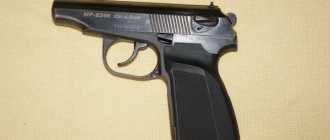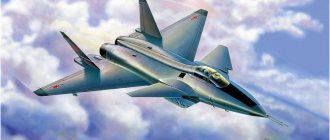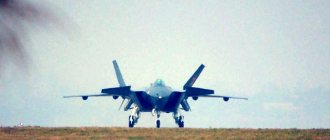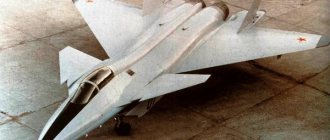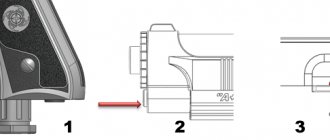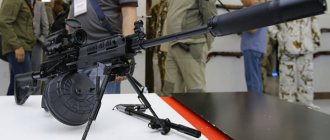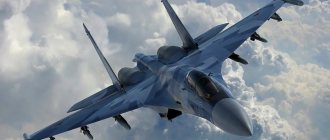The Su-27SM fighter model is a qualitatively new and deeply modernized version of the Su-27 type aircraft. The most significant differences in these vehicles affected the steering system and the combat equipment system. The armament of the new vehicle included qualitatively new weapons that can hit targets both on land and over the sea. The new aircraft is also equipped with the latest generation radar system, which allows you to track objects.
In addition, pilots have a helmet-mounted system that allows them to indicate targets. This aircraft is a fairly new and progressive machine, especially since it can perform very complex flight maneuvers that no foreign analogue can do. The Su-27SM type aircraft entered service in the Russian Federation only in 2009.
Photos
History of creation
3.1 Start of development
In the late 60s, several countries began developing fourth-generation fighters. The pioneers in this were the United States of America, which in 1974 produced the F-15B and 15A “Eagle” fighters.
The Soviet Union responded to this by opening a competition for the development of a promising front-line fighter, in which three design bureaus took part. At first, Sukhoi's experimental design bureau did not participate in the project, as it was busy with other developments. But in 1969, the Sukhoi Design Bureau completed initial studies on promising front-line fighters, and two years later work began on the T-10 product. Since not everyone liked the idea of an integral layout of a glider with a delta wing, approximately 15 models, differing from each other in layout, were tested in a wind tunnel at the Central Aerohydrodynamic Institute. After this, there was a return to the first project, but at the same time the development of an aircraft with a conventional design, a two-fin high-wing aircraft with air intakes located on the sides, began. This option began to be considered due to the airframe layout of the F-15, USA.
After all, the fighter being created was mainly required to ensure supremacy in the sky, and in this it will be competed with by this glider, which will also become its probable adversary.
The combat tactics in the sky also included close maneuver combat, which was the main element of the combat use of the aircraft.
In 1972, the Yak-45 and Yak-47 projects dropped out of the competition. The MiG design bureau proposed to produce a section of the program for a promising front-line fighter and simultaneously work on light and heavy aircraft with the greatest unification of equipment, which would make the production process less expensive and faster. Also, light and heavy fighters will be given their own range of tasks.
3.2 Adoption
The T-10S fighter began serial production in 1981 at plant 126 (Komsomolsk-on-Amur). The Su-27 began to enter service unofficially in 1982, and officially eight years later, after the deficiencies discovered during testing were corrected. By this time, the fighters had already been in use for over five years. In air defense aviation, the Su-27 was designated Su-27P, interceptor, and in the air force - Su-27S, serial. The interceptor could not shoot at targets on the ground due to the fact that it had simpler equipment.
Continuation of "Twenty Seven"
Since 1984, when serial production of the “twenty-seventh” began at factories in Komsomolsk-on-Amur, Irkutsk and Novosibirsk, about one and a half thousand Su-27 aircraft and its modifications, as well as modern Su-30, Su-33, Su -34, Su-35.
The Su-30 fighter became a further continuation of the “twenty-seventh”. Among its new products is a radar station with a phased antenna array. This ensures automatic detection and tracking of targets at long distances and in close combat. In addition, the Su-30 is equipped with powerful electronic warfare systems for self-defense, both from enemy fighters and air defense systems. The Su-30SM (serial, modernized) is currently being actively supplied to the Russian Aerospace Forces. In 2016, Russian Knights also began operating these aircraft.
Su-30 fighters have always been a huge success on the international market; many export modifications have been created: MKK - for China, MKM - for Malaysia, MK2V - for Vietnam, MKI - for India. The Su-27 itself was a great commercial success in the world. Export modifications - Su-27SK and Su-27UBK - have been produced since 1991, and since 1998, licensed production of the Su-27SK has been organized in China under the designation F/J-11.
The youngest “successors” of the Su-27 – the multirole fighter Su-35 and the fighter-bomber Su-34 – in their characteristics practically correspond to the fifth generation of aviation. A new information and control system, the latest Irbis radar are installed on board the Su-35, and AL-41F1S engines, even more powerful than those on the Su-30SM, are responsible for super-maneuverability.
The Su-34 fighter-bomber can carry the entire range of airborne weapons, while attacking targets in all weather conditions, and also effectively conduct electronic warfare. A distinctive feature of these machines is the cockpit, which is unusual for a dryer. To increase crew comfort during long-distance flights, it was decided to seat the pilots next to each other, rather than one after another. The “nose” of the aircraft became wider than that of the Su-27. Because of this unique nose shape, the pilots nicknamed the Su-34 “duckling”.
After 40 years in the sky, the “twenty-seventh” still cannot be called obsolete. Created using the most advanced technologies of its time, it served for decades, became a strong foundation for an entire dynasty of domestic fighters and laid the foundation for the birth of the future air fighter of the Russian Aerospace Forces - the first Russian fifth-generation fighter Su-57.
Weapons and equipment
The N001 pulse-Doppler airborne radar station has a quantum optical-location station equipped with a 36Sh laser rangefinder, capable of tracking targets in simple weather conditions with high accuracy. The radar also has a Cassegrain antenna with a diameter of 1076 mm, which can find targets on the ground and in the air with active interference. The optical location station has the ability to track a target while not far from it, without violating the fighter’s camouflage and not emit radio emissions. Data from the optical-location and airborne radar stations goes to the display frame on the windshield and the line-of-sight indicator.
4.1 Air-to-air mode
For air targets, with a minimum speed of 210 km/h, with a probability of 0.5, the minimum difference between the carrier and the target is 150 km/h.
- Target detection range: fighter class (effective scattering area - 3 m² at average altitude, over 1000 m), ZPS - 25 - 35 km, PPS - 80 - 100 km, 150 km when operating in long-range detection mode
- Finding up to ten targets
- Hit one target
- Guiding up to two missiles at one target
4.2 Air-to-ground mode (only for Su-30, Su-27SM)
- Surface mapping is possible: detection of targets over water and on the ground in mapping mode with synthetic antenna aperture with high and medium resolution, real beam mapping mode, moving targets in their selection mode. Measurement and tracking of coordinates on the ground.
- Detection in the selection mode of moving targets of a tank with an effective dispersion area of 10 m² or more, moving at 15-90 km/h
- Detection range, km: aircraft carrier - 350, effective dispersion area (RCS) - 50,000 m²; missile boat - 50-70, EPR - 500 m²; destroyer - 250, ESR - 10,000 m²; boats – 30, EPR – 50 m²; railway bridge – 100, EPR – 2000 m².
- MTBF 200 hours.
Interesting Facts
— The Pugachev Cobra aerobatic maneuver was first performed on the Su-27. Moreover, it was carried out by test pilot Igor Volk, but gained wide popularity after test pilot Viktor Pugachev demonstrated the aircraft’s capabilities at Le Bourget in 1989. It was then that this name was assigned to it.
— For a long time, the Russian Knights aerobatic team performed on Su-27 fighters. Later, the pilots received Su-30SM and Su-35 aircraft.
— Composite materials were not used to manufacture the Su-27, but 30 percent of the airframe and consoles are made of titanium.
— In the USA, two Su-27s belong to private individuals.
— Visually, the Su-27 can be distinguished by its single-wheeled front landing gear (except for the Su-27K), and the sight of the optical location station (Su-27SM, Su-27SM3). In addition, the Su-35 does not have a retractable brake flap behind the cockpit and the area of the vertical tail is slightly reduced, while the Su-30 (except for the Su-30MK version) has a front horizontal tail, which is absent on the Su-27UB.
Modifications
- Su-27S (Su-27) (Flanker-B) is the main production modification, a single-seat fighter-interceptor of the Air Force.
- Su-27SK (1991) – export version of the single-seat Su-27 (Su-27S).
- Su-27SM (2002) - modernization. It mainly affected the fighter's weapons control system.
- Su-27SM3 - based on the backlog of export Su-27K, 12 aircraft were produced. The main changes are as follows: the airframe has been strengthened, AL-31F-M1 engines with a thrust of 13,500 kgf have appeared, and there are additional suspension points.
- Su-27SKM (2002) - a variant of the Su-27SM for sale to foreign countries. Its characteristics are similar to the Su-30MK2, Su-30MKK.
- The Su-27P is a single-seat interceptor fighter designed for air defense forces. It only shoots down air targets.
- Su-27UB (T-10U) (Flanker-S) is a two-seat combat training fighter. Necessary for training to fly the Su-27; in its nose there is a radar station N001 radar. Produced since 1986.
- Su-30 (Su-27PU) is a two-seat target acquisition and guidance aircraft. Based on the Su-27UB. Four Su-27 interceptors can be targeted simultaneously.
- Su-27UBK is a variant of the Su-27UB for sale to foreign countries.
- Su-33 (T-12, Su-27K) (Flanker-D) is a carrier-based single-seat fighter with folding wings. Produced since 1992.
- Su-33UB (T-12UB, Su-27KUB) is a carrier-based combat training fighter. Features a side-by-side seat arrangement.
- Su-34 (Su-32FN, Su-27IB) (Fullback) is a two-seat fighter-bomber in which the seats are in a shoulder-to-shoulder position. Necessary for firing at surface or ground targets with a high degree of security at any time of the day. All-weather. The functionality is the same as that of the US-made F-15E fighter. The first flight was carried out in the spring of 1990.
- Su-35S (Su-35BM) (Flanker-E+) is a multi-role fighter. Unlike the Su-27M, it has thrust vectoring engines and no horizontal tail surface.
5.1 Ukrainian modifications
- Su-27UB1M - modernization of the Su-27UB.
- Su-27UP1M - modernization of the Su-27UP.
- Su-27S1M - modernization of the Su-27S.
- Su-27P1M - modernization of the Su-27P.
The losing element of the Su-27SM3 upgrade: an update for show. Vague prospects for generation 4+
In a situation where representatives of the defense department of an Eastern European state as hostile to Moscow as Poland are almost at the finish line regarding the conclusion of a multi-billion dollar contract with the military-industrial corporation Lockheed Martin for the purchase of 32 promising F-35A stealth fighters, and a temporary The British-Japanese association "MBDA - Mitsubihi Electric Corporation" is painstakingly working on the hardware and software integration of the unique Japanese active RGSN with AFAR into the equipment of the Meteor ultra-long-range air combat missile (within the framework of the JNAAM project), the issue of expanding the capabilities of airborne radars is beginning to become particularly acute means and air-to-air missile weapons for tactical aviation of the Russian Aerospace Forces.
Taking into account the encouraging information from the head of installation and testing production of the Irkutsk Aviation Plant Andrei Balchugov about the launch of a program of deep modernization of the transitional generation Su-30SM fighters to the “SM1” version (with the replacement of the existing Bars-R radar with a more “far-sighted” version, it is possible , variant N035 “Irbis-E”), we can come to the conclusion that the Russian Ministry of Defense and PJSC “are doing everything possible today to give the Aerospace Forces of the Russian Federation, if not superiority, then at least confident parity with the United Air Forces of NATO countries. However, given the bleak forecasts regarding the future pace of updating the Aerospace Forces fighter aircraft fleet with promising Su-57 aircraft complexes capable of equal resistance to Raptors and Lightnings, as well as regarding the “unfreezing” of the air combat missile project with the RVV ramjet engine -AE-PD, the above conclusion, based only on the development of the Su-30SM line, can hardly be considered objective.
Even if we assume that the total number of Su-30SM/SM1 aircraft delivered to combat units of the Russian Navy's Aerospace Forces and naval aviation will approach 150-170 units by 2022, and Su-35S - 100 units, any statement about their ability to seize the initiative in the struggle for air supremacy in the Baltic or Central European theaters of military operations will encounter a cruel reality due to the significant numerical and partial technological superiority of tactical aviation of the NATO and US Air Forces. In particular, the air forces of France, Great Britain, Norway and Sweden and Poland alone, in the event of an escalation of a major conflict in the European theater of operations after 2022, can be involved in an operation to form an air defense “barrier” over the North Sea, as well as the southern and southwestern parts of the Baltic Sea order:
- 50-70 multifunctional Rafale F3R fighters, equipped with modern radars with RBE-2AA AFAR, as well as MBDA Meteor URVB adapted for use;
— 80-100 multirole fighters EF-2000 “Typhoon”, most of which by that time will receive AFAR radars “Captor-E” from “Selex” with hardware support for electronic warfare in the “Radar 2 configuration” version and a mechanical drive for turning the canvas AFAR in the azimuthal plane (previously, the classic AFAR architecture provided only a fixed canvas), as well as the possibility of using “direct-flow” Meteors in the HCU software version of the Block 15 fighter;
— 100 multifunctional Gripen fighters in the JAS-39C/D modifications of the MS20 standard and JAS-39E/F Gripen-NG (the second version will receive the promising ES-05 Raven AFAR radar with increased energy capabilities);
- more than 50 5th generation F-35A/B fighters, equipped with the most advanced radars with active AN/APG-81 phased arrays (equipped with an electronic warfare option due to the use of several groups of transceiver modules), as well as infrared detection systems for attacking missiles and remote heat-contrast targets AN/AAQ-37 with a distributed aperture (represented by 6 IR sensors distributed throughout the airframe of the vehicle).
It is worth adding here that specialists from the British division of the defense concern MBDA have already begun adapting the aerodynamic design of the Meteor missiles for placement in the internal weapon bays of the stealthy F-35A and F-35B fighters, which will only complicate the already difficult situation for our “dryers” , deprived of the promising RVV-AE-PD missile. The above list of enemy tactical aviation can be safely supplemented with several hundred carrier-based multirole fighters of the “4++” generation F/A-18E/F “Super Hornet” of the US Navy, which will be deployed to the European theater of operations (North and Norwegian seas) as soon as possible. This is where our Aerospace Forces will encounter a noticeable superiority of the enemy, to counter which 200-250 Su-30SM/1 and Su-35S, as well as 50-100 new MiG-35s, to put it mildly, will not be enough.
It is obvious that in the light of such a prospect, the Russian Ministry of Defense should already have a win-win trump card up its sleeve today, which consists in the possibility of quickly increasing the potential of the Aerospace Forces in carrying out tasks to gain air superiority by updating and immediately sending hundreds of 4-4 vehicles to the combat units of the Aerospace Forces. th generation. And, at first glance, we already have such a trump card. We are talking about a deep modernization of the fleet of Su-27S/P fighters to the level of the Su-27SM3. Work in this direction is carried out on a regular basis by specialists from the Komsomolsk-on-Amur Aviation Plant named after Yu.A. Gagarin (KnAAZ) starting from 2010: initially, under the contract for the assembly and improvement of 12 Su-27SK vehicle sets not delivered to the Celestial Empire, concluded between the defense department and PJSC “in 2009, then, in accordance with the second contract for updating 36 aging combat vehicles Su-27S/P vehicles, signed in the spring of 2015.
Meanwhile, no matter how unpleasant it may sound to us, the full and timely implementation of even such a seemingly standard program for the military-industrial complex of the Russian Federation caused significant difficulties associated with underfunding, which subsequently led to a revision of the terms of the 2015 contract and reducing the number of Su-27S/P fighters to be modernized from 36 to 10 aircraft. The processing of the last vehicle from the last contract into the “SM3” modification was completed in 2018, as KnAAZ director Alexander Pekarsh (a branch of PJSC “) recently told RIA Novosti reporters.
But let’s try for a moment to discard the extremely painful situation for the combat potential of the Aerospace Forces with the reduction of the order for the modernization of the Su-27S/P and focus on assessing the technical capabilities of the updated Su-27SM3 (after all, over the 10-year period of the program’s existence, KnAAZ has accumulated unique experience in optional upgrades “ Sushek", which makes it possible to quickly resume the program after concluding new contracts, especially considering the presence of a significant number of Su-27S/P in storage and the processing of early versions of "SM" into "SM3"). Based on information received from official sources, we can conclude that the radio-electronic “filling” has undergone a radical update.
Firstly, the cockpit received a more or less modern information field, represented by 4 multifunctional MFI LCDs, which display not only information about the tactical air and ground/surface situation received from the on-board radar and third-party sources through the on-board K-DlAE data exchange complex /I, but also detailed information about the location of enemy radiation sources (radar detectors, illumination radars and active radar seekers), obtained by the modern integrated radiation warning system L-150 “Pastel”. In contrast to the outdated and low-resolution SPO-15 (L006) “Beryoz” with a lamp-sound indicator for warning of exposure and classification of only 6 types of radar equipment, “Pastel” can safely be considered as a full-fledged element of tactical electronic reconnaissance, capable of identifying up to 128 emitting sources thanks to the presence of a drive with the proper amount of memory.
Software and hardware upgrade of the SUV-27E weapons control system provided the possibility of using medium-range air-to-air missiles RVV-AE/RVV-SD, equipped with active radar seekers, as well as a wide range of air-to-surface weapons, including anti-radar missiles Kh-31P and anti-ship Kh-31A/AD. KnAAZ also did not skimp on strengthening the airframe structure with the simultaneous addition of suspension units and the installation of more powerful AL-31F-M1 turbofan engines, which provided the fighter with an excellent thrust-to-weight ratio of 1.22 kgf/kg at normal take-off weight (corresponding to the level of the best representatives of the 5th generations); the ability to maneuver with high overloads even with an air-to-surface suspension configuration (naturally, with a moderate number of deployed missiles of the X-38, X-29 and X31 families); as well as a slight reduction in the rate of ammunition depletion.
There is also a detail that overshadowed all, without exception, the positive qualities of this modification of the “Flanker”. We are talking about a hopelessly outdated airborne radar of the N001VE type with a Cassegrain antenna array, which has extremely low noise immunity, a mediocre “capture” range for targets like “Rafal” or “Typhoon” (no more than 90 km), as well as the inability to detect ultra-small air objects that are safely detected by Bars and Irbis radars. The only real advantage of this radar is the introduction of the “air-to-surface” mode through the introduction of the so-called. bypass channel.
In the event that EA-18G “Growler” electronic warfare aircraft appear on the air theater of operations, equipped with AFAR stations for generating targeted response and noise interference AN/ALQ-249 NGJ Inc. 1, the Su-27SM3 pilot will not be able to count on receiving reliable data on air and ground conditions from his own N001VE radar and will have to rely only on the K-DlAE/I tactical communications terminal, which will receive data either from Su-30SM/1 and Su-35S, or from the NKVS-27 ground air communications complex, which relays information about the tactical situation from AWACS aircraft, as well as other target designation means. In this case, everything will depend on the methods of protecting the NKVS-27 radio data exchange channels, covering the decimeter frequency range from 960 to 1215 MHz.
Airborne AFAR radar AN/APG-63(V)3 as part of the avionics of the US Air Force F-15C fighter
Based on the fact that NKVS-27 uses the principle of encoding a radio signal, which coincides with that of the on-board information exchange station S-108 of the Su-35S fighter (Reed-Solomon code with simultaneous pseudo-random tuning of the operating frequency), one can hope that the pilot of the Su -27SM3 will be able to maintain situational awareness even in the face of opposition from the Growlers; but unfortunately, the possibility of using RVV-SD missiles will be reduced only to pointing at the source of interference, since the effective range of the N001VE radar in conditions of radio countermeasures will be reduced by more than 2 times.
The situation can be easily corrected by re-equipping the Su-27SM3 with Bars/Irbis radars, as well as more powerful 120 hp VK-150 auxiliary units. in power node mode. Unfortunately, the possibility of introducing this clause into the terms of the contract for the modernization of the Su-27S/P family was not mentioned even once by our military-diplomatic sources, while overseas the program for re-equipping combat F-15C/D “Eagle” is in full swing. and F-15E “Strike Eagle” to advanced radars with AN/APG-63(V)3 and AN/APG-82(V)1 AFAR.
Sources of information: https://bmpd.livejournal.com/3550821.html https://www.militaryaerospace.com/articles/2015/11/f-15-radar.html https://vpk.name/news/174483_afar_dlya_f15 .html https://www.arms-expo.ru/armament/samples/1491/72661/ https://bastion-karpenko.ru/su-27sm/
Experimental aircraft
- T-10 - prototype.
- T-10S is an improved prototype.
- Su-27 is a pre-production version equipped with AL-31 engines.
- The Su-27IB is a prototype of the two-seat fighter-bombers Su-34 and Su-32FN, in which the seats are side by side. Necessary for firing at surface or ground targets with a high degree of security at any time of the day. All-weather. The first flight was carried out in the spring of 1990.
- P-42 (T-10-15) - converted from Su-27. In the second half of the 80s, they set 41 world records for flight altitude and rate of climb, registered by the Fédération Aéronautique Internationale. The weight has been reduced quite significantly (the maximum take-off weight is 14.1 tons), and uprated engines have also appeared.
- Su-27M (T-10M) (Flanker-E) is a multi-role fighter. The power of the PGO and radar has been increased. It was exported under the designation Su-35. The Su-35 has slightly changed equipment and design depending on the specific customer.
- Su-35UB (T-10UBM) is a combat training aircraft based on the Su-27M, Su-30 and Su-37. Produced in one copy.
- Su-37 (T-10M-11) (Flanker-F) is a multi-role fighter with engines equipped with a thrust vector control system or, in short, UVT b/n 711. Based on the Su-27M with PGO. One aircraft produced.
MODIFICATIONS OF SU-27
The Su-27 family includes many modifications. Within this family of aircraft there are four “lines”:
- single-seat fighter Su-27,
- two-seat Su-27UB (combat training) and Su-30 (designed to control the actions of groups of fighters);
- carrier-based fighter Su-33 (for the Admiral Kuznetsov TAVKR air group, 26 units were produced);
- front-line bomber Su-32FN/Su-34.
Modifications of the single-seat Su-27 fighter will be considered here.
T-10
The first prototypes that never went into production.
Su-27 (T-10S)
A radically modernized T-10, actually a new aircraft, the letter “S” stands for “Serial”. The shape of the airframe was almost completely changed; a wing with straight tips was installed. The keel tips of the first production Su-27s were made straight, later they began to be beveled, the shape of the central tail boom changed, and anti-flutter weights disappeared from the keels. The maximum take-off weight of late-built aircraft increased to 33,000 kg, and the flight range to 4,000 km. On some aircraft, instead of external pylons, containers with electronic warfare equipment are installed (at the ends of the wing).
Su-27P
Single-seat fighter-interceptor for air defense forces. The possibility of working on the ground is excluded from the weapons control system; The composition of the avionics has been slightly changed.
Su-27SK
Serial commercial version of the Su-27 fighter. Produced since 1991 in Komsomolsk-on-Amur. Often designated simply as Su-27K (previously the designation Su-27K was adopted for carrier-based fighters, but then they were renamed Su-33).
Su-27SKM
The export version of the Su-27SKM was developed in the mid-1990s; it differs from the Su-27SK in the updated composition of its avionics, the number of missile hardpoints has been increased to 12. The aircraft's missile armament is supplemented with RVV-AE air-to-air missiles and air-to-air guided weapons - surface", including the Kh-29T missile launcher, Kh-31 anti-ship missiles and KAB-500 laser-guided bombs. Combat load increased to 8000 kg. The ability to attach two fuel tanks with a capacity of 2000 liters to the underwing units has been added.
Su-27M (Su-35)
The Su-27M has been developed since 1988 as a multi-role air superiority fighter with even greater maneuverability than the Su-27. At the same time, its strike capabilities have become wider than those of the Su-27. In 1993, this fighter received the designation Su-35.
Projections of the Su-35 fighter |
The aircraft is designed according to the “integral triplane” design with a front horizontal tail. Composite materials are used more widely in the airframe design than in previous modifications.
Additional fuel tanks are located in the larger keels; the capacity of the internal tanks has increased by 1,500 kg. The fighter was able to refuel in the air. The retractable fuel receiver is mounted on the left side in front of the cabin.
Onboard electronic warfare equipment is capable of providing both individual and group protection. To a limited extent, the aircraft is capable of conducting electronic reconnaissance. It is equipped with a new optical location station and N-011 radar with a target detection range of up to 400 km, capable of simultaneously tracking up to 15 targets and launching missiles at six of them. The aircraft is capable of using air-to-surface guided weapons. The instrumentation is made according to the “glass cockpit” principle.
The super-maneuverable multirole fighter Su-35 is a deep modernization of the Su-27 and belongs to the “4++” generation. Its design began in 2002. The Su-35 uses 5th generation fighter technology and radically improved avionics. The power plant consists of two AL-41 turbofans of increased thrust with nozzles rotating in two planes. The fighter is equipped with a H035 Irbis passive phased array radar.
A total of 12 Su-27M/Su-35 were built, some of them were transferred to the Russian Knights aerobatic team. However, the Su-35 fighter construction program is currently closed.
Su-27SM
In 2004-2009, 48 Su-27 fighters were repaired and upgraded to the Su-27SM variant for the Russian Air Force. Under the so-called “small modernization” program, cockpit instrumentation and part of the avionics were replaced (there is the ability to detect ground and surface targets), the airframe was modified; the aircraft gained the ability to use air-to-surface guided weapons.
P-42
One of the first production Su-27 (T-10-15) was made as light as possible to set a world rate of climb record; in order to reduce weight, the paint was even washed off from the aircraft. The take-off weight was reduced to 14,100 kg, the afterburner thrust of each engine was increased to 29,955 kN. In 1986-1988, the P-42 set 27 world speed and climb records.
T-10-20
The serial T-10-20 was modified into a version for breaking the speed record on a closed 500-km route; no world record was set. The aircraft was lightened, ogive-shaped tips were installed on the wing (similar to the first T10), the fuel capacity was increased to 12900 kg
T-10-24
The serial T-10-24 was converted into a flying laboratory to evaluate the effect of the front horizontal tail (FHT) on stability and controllability.
T-10-26 (LL-UV (KS))
Another flying laboratory for testing the AL-31F engine with an experimental rotary nozzle. The T-10-24 was converted into it.
Su-37
In 1995, the Su-27M No. 711 was equipped with AL-31 FP engines with a thrust of 14,510 kgf in afterburner and thrust vector control. This fighter was named Su-37.
Su-37 fighter |
The avionics and control system of the fighter were significantly modernized. The instrumentation is made according to the “glass cockpit” principle, equipped with four large-format color displays and a wide-angle indicator on the windshield. The aircraft is equipped with a quad-duplex digital fly-by-wire control system. Instead of the usual control stick, a side joystick was installed in the cockpit, and the engine controls were changed.
The Su-37 fighter was equipped with two radars: an upgraded pulse-Doppler N011M with phased array, located in the forward part of the fuselage, and a rear hemisphere viewing station, which provides control of missiles launched into the rear hemisphere.
The optical-electronic systems of the fighter included a thermal imager combined with a laser rangefinder-target designator.
The aircraft was able to refuel in the air by being equipped with a retractable fuel receiver boom.
The controlled thrust vector allowed this fighter to perform effective combat maneuvers at near-zero speeds, which are simply impossible to perform on the Su-27 with conventional engines. Among them are the well-known maneuver “Frolov’s Chakra” (“dead loop”, only with a very small radius, actually turning the aircraft around its tail), a forced combat turn (in less than 10 seconds) and others.
Unfortunately, fighter No. 711 crashed during a test flight in 2002. The Su-37 program has now been discontinued.
Chinese Su-27
In 1991, a contract was signed to supply China with 20 Su-27SKs, and in 1996 - for another 16 Su-27SKs. In China, the aircraft was designated J-11. Deliveries began in 1992. The aircraft of the second batch were distinguished by the ability to install Sorption electronic warfare containers, a reinforced landing gear and the ability to use unguided air-to-surface weapons. In 1996, China acquired a license to produce 200 Su-27SK aircraft without the right to re-export to third countries.
China has repeatedly insisted on modernizing the J-11 by replacing the H001 radar with a more advanced one, expanding the range of air-to-air missiles and installing multifunctional indicators in the cockpit. By 2006, about 60 J-11s had been modified into the J-11A variant. The country was also developing its own version of the Su-27 with WS-10A engines, a new Chinese-designed radar and the ability to use Chinese-designed guided weapons. China officially confirmed the existence of the J-11B in May 2007. In 2010, it was officially announced that the J-11B fighters were entering service with the Chinese Air Force, which supposedly have nothing in common with the Su-27.
In total, the Chinese Air Force currently operates a total of 276 Su-27, Su-30 and J-11 aircraft.
Comparative performance characteristics
9.1 Technical specifications
- Crew, people: project (T10-1), Su-27P(S), Su-27SK, Su-27SM – 1; Su-27UB - 2
- Length, m: project (T10-1) - 18.5; Su-27P(S), Su-27SK, Su-27SM, Su-27UB - 21,935
- Wing span, m: project (T10-1) - 12.7; Su-27P(S), Su-27SK, Su-27SM, Su-27UB - 14,698
- Height, m: project (T10-1) - 5.2; Su-27P(S), Su-27SK, Su-27SM - 5,932; Su-27UB - 6,537
- Wing area, m²: project (T10-1) – 48; Su-27P(S), Su-27SK, Su-27SM, Su-27UB - 62.04
- Wing aspect ratio: project (T10-1) - 3.38; Su-27P(S), Su-27SK, Su-27SM, Su-27UB - 3.5
- Wing taper coefficient: project (T10-1) - 6.57; Su-27P(S), Su-27SK, Su-27SM, Su-27UB - 3.4
- Sweep angle: project (T10-1) - 45°; Su-27P(S), Su-27SK, Su-27SM, Su-27UB - 42°
- Chassis base, m: project (T10-1) – no data; Su-27P(S), Su-27SK, Su-27SM, Su-27UB - 5.8
- Chassis track, m: project (T10-1) - 1.8; Su-27P(S), Su-27SK, Su-27SM, Su-27UB - 4.34
- Empty weight, t: project (T10-1), Su-27SM - no data; Su-27P(S) – 16.3; Su-27SK – 16.87; Su-27UB – 17.5
- Normal take-off weight, t: project (T10-1) – 18; Su-27P(S) - 22.5; Su-27SK - 23.4; Su-27SM - 23.7; Su-27UB - 24
- Maximum take-off weight, t: project (T10-1) – 21; Su-27P(S) – 30; Su-27SK, Su-27SM – 33; Su-27UB - 30.5
- Fuel mass, kg: project (T10-1) – no data; Su-27P(S), Su-27SK - 9,400/5,240; Su-27SM, Su-27UB - 9,400/6,120
- Fuel volume, l: project (T10-1) – no data; Su-27P(S), Su-27SK - 11,975/6,680; Su-27SM, Su-27UB - 11,975/7,800
- Powerplant: two AL-31F turbofan engines
- Non-afterburning thrust, kgf (*10 N): project (T10-1) - no data; Su-27P(S), Su-27SK, Su-27SM, Su-27UB – two for 7,600
- Afterburner thrust, kgf (*10 N): project (T10-1) – two per 10,300; Su-27P(S), Su-27SK, Su-27SM, Su-27UB - two for 12,500
9.2 Flight characteristics
- Maximum speed at an altitude of 11000 m, km/h: project (T10-1), Su-27P(S), Su-27SK, Su-27SM - 2,500 (M=2.35); Su-27UB - 2,125 (M=2.0)
- Maximum ground speed, km/h: project (T10-1) - 1,400; Su-27P(S), Su-27SK, Su-27SM, Su-27UB - 1,380
- Landing speed, km/h: project (T10-1) – no data; Su-27P(S), Su-27SK, Su-27SM – 225 – 240; Su-27UB – 235 – 250
- Stall speed, km/h: project (T10-1), Su-27SK, Su-27SM, Su-27UB - no data; Su-27P(S) - 200
- Range, km (near the ground/at altitude): project (T10-1), Su-27SK, Su-27SM, Su-27UB - no data; Su-27P(S) - 440/1 680
- Practical range, km (near the ground/at altitude): project (T10-1) - 800/2,400; Su-27P(S) - 1,400/3,900; Su-27SK - 1,370/3,680; Su-27SM - no data/3,790; Su-27UB - 1,300/3,000
- Practical ceiling, m: project (T10-1) - 22,500; Su-27P(S), Su-27SK - 18,500; Su-27SM - 18,000; Su-27UB - 17,250
- Rate of climb, m/s: project (T10-1) – 345; Su-27P(S) – 285 – 300; Su-27SK, Su-27SM, Su-27UB - no data
- Take-off run length, m: project (T10-1) – 300; Su-27P(S) – 650 – 700; Su-27SK – 700 – 800; Su-27SM – 650; Su-27UB – 750 – 800
- Run length, m: project (T10-1) – 600; Su-27P(S) – 620 – 700; Su-27SK, Su-27SM – 620; Su-27UB – 650 – 700
- Wing load, kg/m²: project (T10-1) – 375; Su-27P(S), Su-27SK, Su-27SM, Su-27UB - no data
- Thrust-to-weight ratio: project (T10-1) - 1.12; Su-27P(S) - 1.2; Su-27SK, Su-27SM, Su-27UB - no data
- Minimum turn radius, m: project (T10-1), Su-27SK, Su-27SM, Su-27UB - no data; Su-27P(S) - 450
- Maximum operational overload: + 9 g
9.3 Armament
- Small arms and cannon: project (T10-1) - 30 mm AO-17A gun; Su-27P(S), Su-27SK, Su-27SM, Su-27UB - 30 mm GSh-30-1 gun
- Ammunition, sn.: project (T10-1) – 250; Su-27P(S), Su-27SK, Su-27SM, Su-27UB - 150
- Weapon suspension units: project (T10-1) – 8; Su-27P(S), Su-27SK – 10; Su-27SM – 12; Su-27UB - 10
- Combat load, kg: project (T10-1) - no data; Su-27P(S) - 6,000; Su-27SK, Su-27SM - 8,000; Su-27UB - 4,000
- Air-to-air missiles: project (T10-1) - two K-25 and six K-60; Su-27P(S), Su-27SK - six R-27 and four R-73; Su-27SM - eight R-27 or four to six R-73 and eight R-77; Su-27UB - six R-27 and four R-73
- Air-to-surface missiles: Su-27SM - six Kh-29 or six Kh-31 or two Kh-59
- Unguided aircraft missiles: project (T10-1) - no data; Su-27P(S), Su-27SK, Su-27SM, Su-27UB - eighty S-8 or twenty S-13 or four S-25
- Air bombs: project (T10-1) - no data; Su-27P(S), Su-27SK - eight per 500 kg or thirty-one per 250 kg or thirty-eight per 100 kg; Su-27SM - eight for 500 kg or thirty-one for 250 kg or thirty-eight for 100 kg or six KAB-500 or three KAB-1500; Su-27UB - 10 at 500 kg or thirty-one at 250 kg or fifty 100 kg
9.4 Avionics
- Radar station: project (T10-1) - Sapphire-23MR; Su-27P(S), Su-27SK, Su-27SM, Su-27UB - RLPK-27
- Antenna diameter, mm: project (T10-1), Su-27SM - no data; Su-27P(S), Su-27SK, Su-27UB - 975
- Air target detection range, km: project (T10-1) – 40 – 70/20 – 40; Su-27P(S), Su-27SK – 80 – 100/30 – 40; Su-27SM - no data; Su-27UB – 80 – 100/30 – 40
- Number of simultaneously tracked targets: project (T10-1), Su-27SM - no data; Su-27P(S), Su-27SK, Su-27UB - 10
- Number of simultaneously attacked targets: project (T10-1), Su-27SM - no data; Su-27P(S); Su-27UB – 1; Su-27SK - 2
- UES: project (T10-1) – yes; Su-27P(S), Su-27SK, Su-27SM, Su-27UB - OEPS-27
- Air target detection range, km: project (T10-1) - no data; Su-27P(S), Su-27SK, Su-27SM, Su-27UB - 15/50
- Height viewing area: project (T10-1) – no data; Su-27P(S), Su-27SK, Su-27SM, Su-27UB - −15°/+60°
- Azimuth viewing area: project (T10-1) – no data; Su-27P(S), Su-27SK, Su-27SM, Su-27UB — ±60°
- Helmet-mounted target designation system: project (T10-1) – yes; Su-27P(S), Su-27SK, Su-27SM, Su-27UB - “Schel-3UM”



